Archives
Reuters technical development chronology 1980-1984
Monday 20 July 2015
- Continuing industrial relations friction in the Dealing project between a unionised Reuters workforce and the outside contractors results in numerous periods of silence between the teams which make some meetings somewhat different and hampers progress. Launch dates come and go.
- Late in the Dealing project the “deal key” is added as a last-minute fix to ensure that when dealers deal there is still contact between them. A failed connection could lead to confusion as to whether the deal had actually been executed. Nearly 12 years later the automated matching system (D-2000 Phase 2) will encounter exactly the same issue (known by then as the ping-pong problem) which delays the launch by one year. It is strange how knowledge and experience get ignored.
PHOTO: Deal key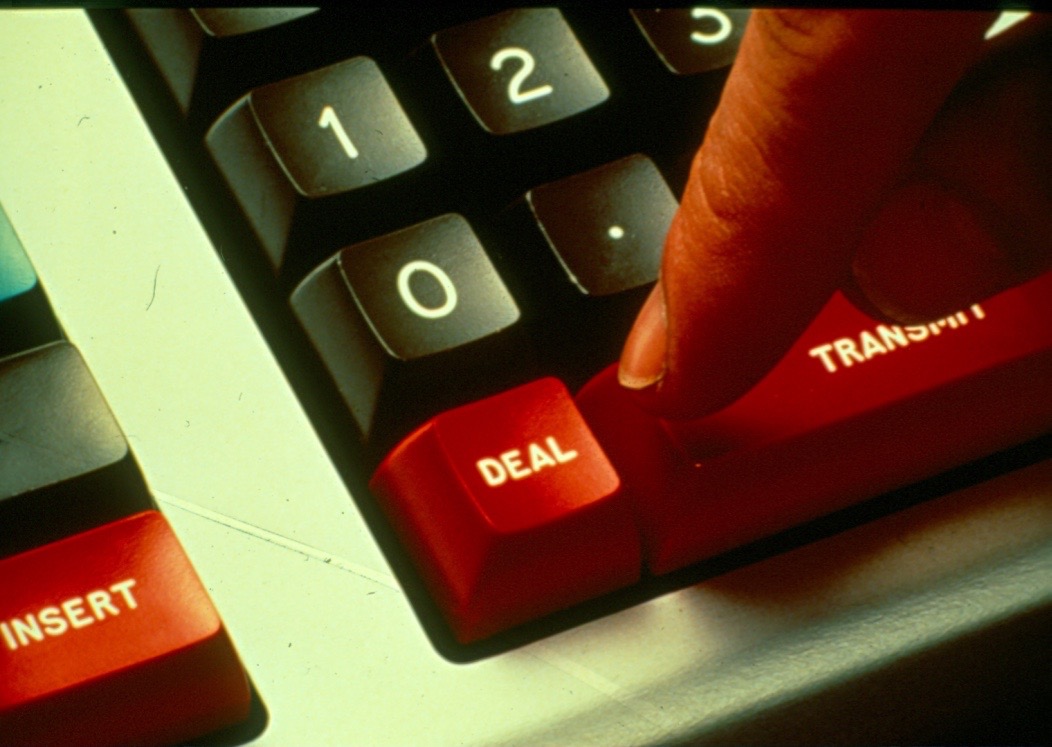
- Regional “Quote Front Ends” (QFEs) are installed to enhance the processing of quotes data from exchanges outside North America and to build up regional databases. These can be distributed locally as required as well as onto the main composite feed.
- The Monitor system capacity is increased by orders of magnitude by using a layer of concentrators rather than direct connections to the Host. The architectural change known as Monitor System expansion (MSE) improves response times, throughput and facilitates the connection of the Dealing system to Monitor.
- The Dealing system is launched to 120 subscribers. Initially known as Reuters Dealing, it is quickly renamed Reuters Monitor Dealing Service (RMDS). It struggles to make headway financially although technically it performs reliably. It uses a hardware “watchdog” monitor developed by Reuters engineers to automatically switch to a cold standby if a failure is detected. RMDS is under the threat of cancellation for some time and every effort is made to cut costs even to the extent of running 3:1 live-to-standby ratios and eliminating disk drives on some devices. This makes software upgrades very laborious. Cheers for that. The development support team is cut from 100 in 1980 to four full-time developers and a handful of part-timers assigned to other projects. On the product it is discovered that the loose rule that anyone can contact anyone isn’t a good idea when countries are at war. Some kludges - quick-and-dirty solutions - are rapidly introduced. Another unexpected complication is explaining the Interrupt Key to users. This is used by a deal maker to remove a price from a hesitating taker and causes some initial friction between counterparties.
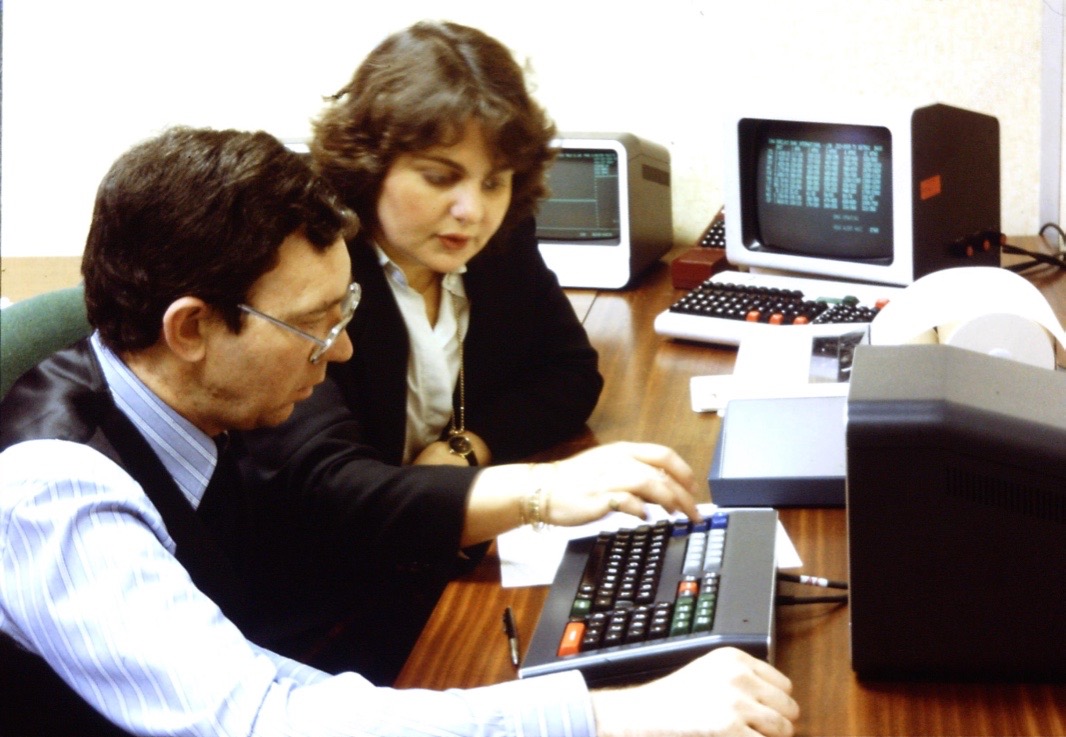
PHOTO: Julie Holland training a Dealing client
- The IBM personal computer arrives. Although not the first in the field it adds credibility as a mainstream development option. To quote the IBM archives, “two decades earlier, an IBM computer often cost as much as $9 million and required an air-conditioned quarter-acre of space and a staff of 60 people to keep it fully loaded with instructions. The new IBM PC could not only process information faster than those earlier machines but it could hook up to the home TV set, play games, process text and harbor more words than a fat cookbook”.
- Rowgrabber is now well established as a delivery mechanism. Data from Reuter systems in New York is fed over the Manhattan cable television network to a transmitter owned by RCA. Data is then beamed by microwave to an uplink in Vernon Valley, New Jersey and transmitted by satellite to IDR-staffed relay stations in Farmingdale (for quality monitoring), Chicago, Dallas, San Francisco, Fort Lauderdale and Los Angeles. At this point the basic system broadcasts around 2,300 pages of information which are constantly recycled at intervals of 2-12 seconds.
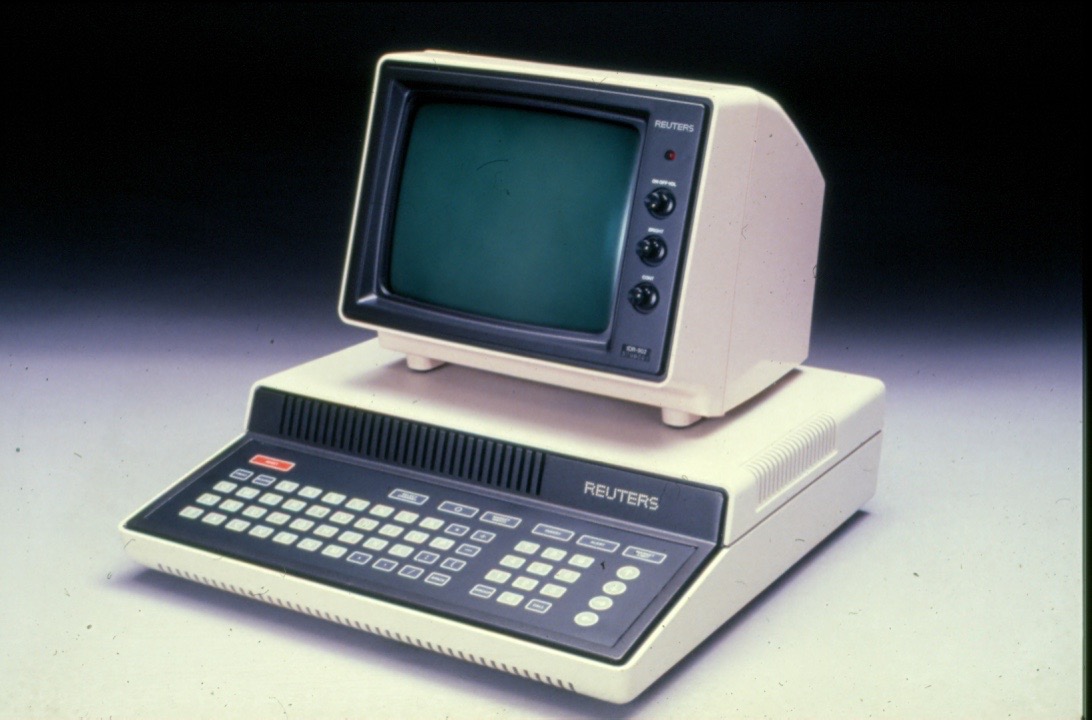
PHOTO: IDR 4P Rowgrabber
- Glen Renfrew is made managing director and immediately puts his technical foot down. London-based projects RSR and MPT are cancelled. Complete trust is put in “two-way” Rowgrabber (which is not yet working) as the next generation of information distribution systems for worldwide application. RSR was definitively cancelled as “it would have taken too long and work on a concept suitable for this field was already at an advanced stage” says Renfrew at a meeting of London-based development staff. The new network will be known as the Reuter Data Network (RDN). It will use a one-way broadcast supported by a two-way network known as Reuternet. All volume terminal developments are to be based at IDR which takes over development of the MPT and renames it the 600MQ. IDR opens new premises to cope with the extra work. It is opposite a fairground appropriately named Adventureland. London development will be reduced to 50 from 120 by natural wastage and transfers to Rowgrabber projects. RNA announces plans to open a new technical centre at Hauppauge, Long Island housing systems from the city locations. The company becomes Rowgrabber mad - any proposal must cite its compatibility with Rowgrabber which was pretty hard given that Rowgrabber was still evolving.
- Monitor is creaking with the pressure of supporting the company’s aspirations although new services continue to be launched such as Shipping. This offers a fast selective broadcast alert with information useful to the users of the service.
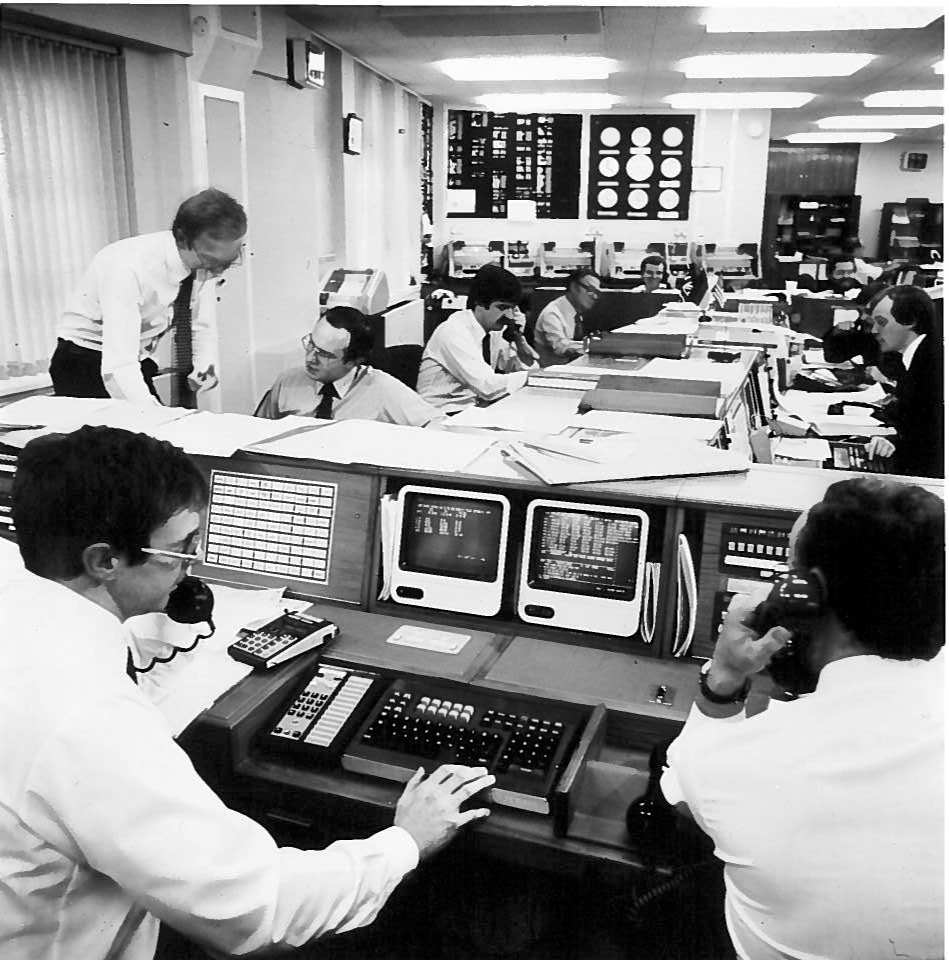
PHOTO: Dealing room with Monitor
- In spite of the above, a Quote to Monitor Interface (QMI) system goes live enabling “quote” data to be carried on Monitor pages rather than just the SGS drum. This releases some of the pressure on SGS capacity but at the expense of increasing the load on Monitor. Committees spring up to manage Monitor page capacity.
- First successful test of the “two-way” grabber system when a single keystation in IDR Farmingdale manages to request data from the cable head in New York over a 1200baud line. It took just over two years to get the concept working. Plans are in hand to upgrade critical RNA systems to VAXes to cope with traffic rates.
- Michael Bloomberg is laid off by Salomon Brothers and starts an information company.
- Reuters engineers design the Eurocom network which replaces the 13-year-old Europlex ring main with more modern technology. It uses a star network rather than a ring.
- The pursuit of broadcast technology in the United States spawns the first Small Dish project SDS-1 which launches in RNA. It uses a two-foot dish (VSAT) to receive a broadcast rowgrabber-fed data stream from an uplink in Farmingdale and deliver it to a new range of IDR terminals. Direct broadcast avoids the Rowgrabber access issues but it is not able to handle a large data stream. It is aimed at the lower priced sector of the market. It will find global success in further incarnations and now can be seen as a ground-breaking step forward.
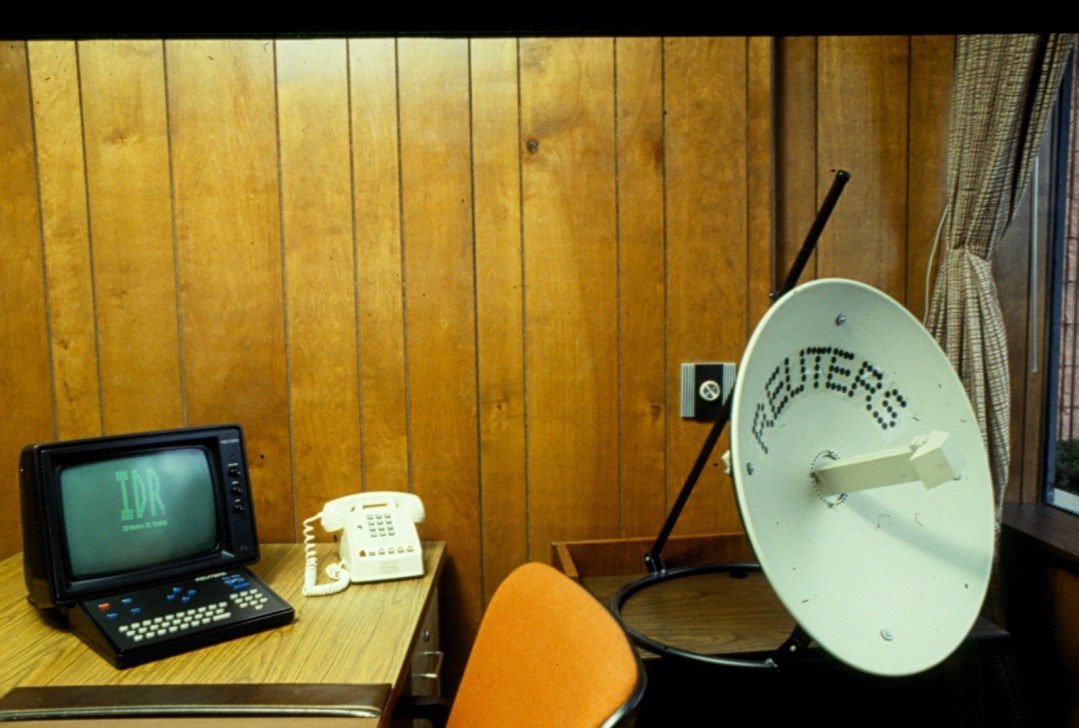
PHOTO: SDS-1
- A major enhancement of the QRS network is implemented with the installation of a “backbone concentrator” which improves general network performance.
- Use of the new technique of statistical multiplexing means that Dealing can be delivered cost effectively to remote locations such as those in Asia and the Middle East. Huge effort goes into proving the technology. Overcoming the communications and costs obstacles brings tremendous benefits to clients and builds towards the critical mass of the Dealing service.
- Development by this time had built a significant testing environment for both Monitor and Dealing which took one complete floor of GSS. Traffic loads could be artificially generated and different configurations which would be met in the field were able to be simulated.
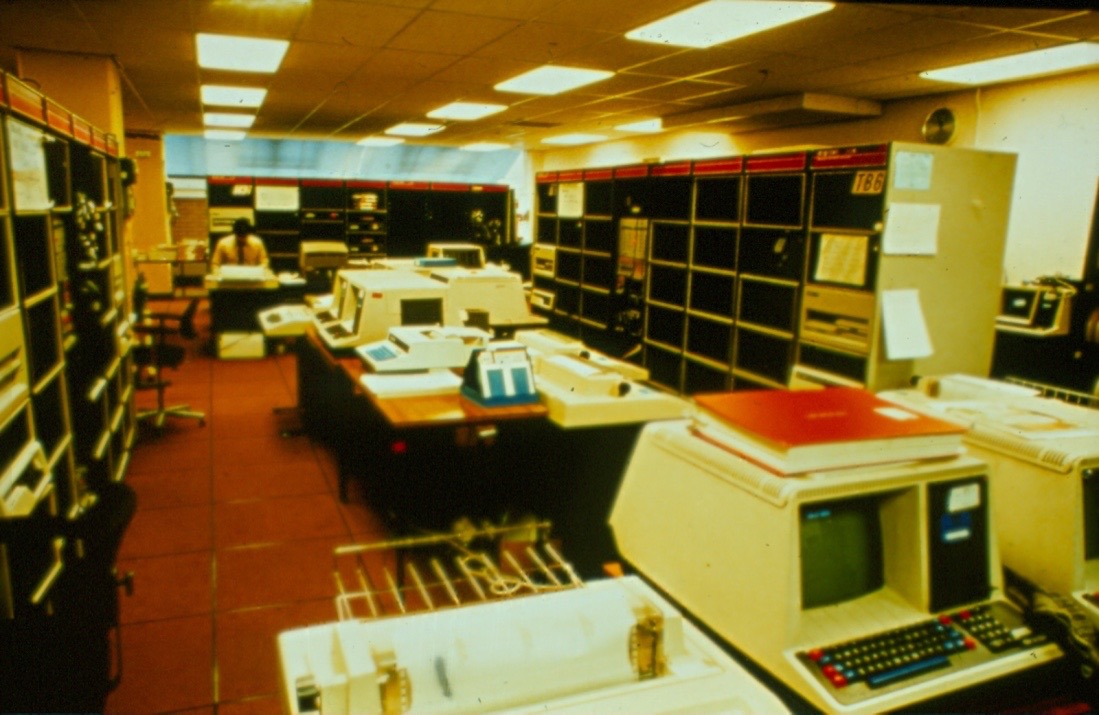
PHOTO: Testbeds at London Technical Centre
- RDN development continues. Questions soon arise as to whether the technology can really cope with the predicted traffic rates. Monitor contributors are a complicating factor in a largely broadcast design. There is huge focus on delivery of all services over a single line, though squeezing the data into the standard 2400 bps lines of the day will not be easy. The design adopts 10Mbs Ethernet for the interconnection of components and for large clients instead of traditional cabling. Given the infancy of the technology this is very far sighted. It also provides for horizontal expansion of components sharing the load instead of ever larger single systems. Having just standardised on the VAX, all VAX developments in RNA are stopped to be replaced by Intel. Staff are retrained.
- RNA Operations relocate to the newly-constructed facility in Hauppauge, Long Island and construct a new uplink replacing RCA Vernon Valley. RNA Development also relocate from New York City shortly afterwards. IDR at Farmingdale is close by.
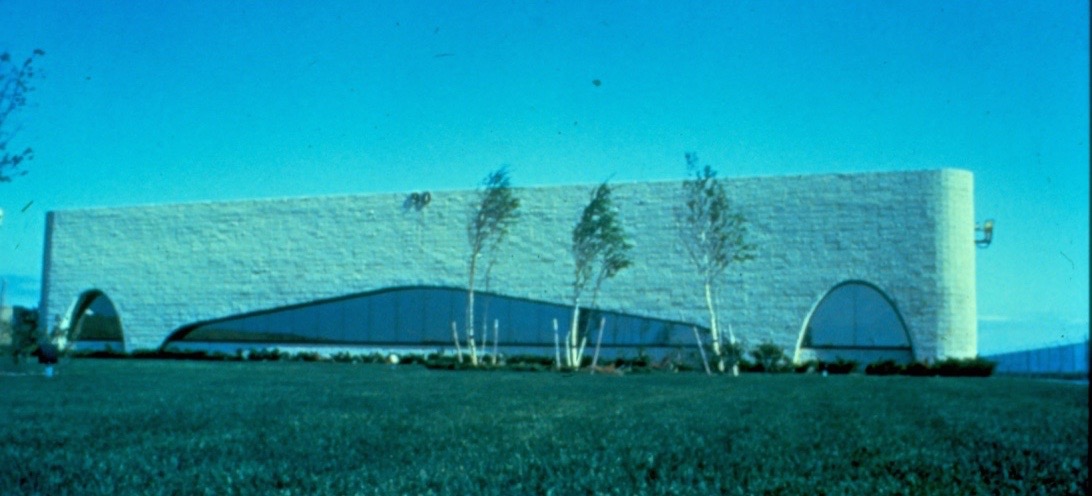
PHOTO: Hauppauge Technical Centre
- IDR set up a new manufacturing facility on Long Island having outgrown Farmingdale which becomes a development only facility.
- The last PDP-8 420 is shipped as all terminals are now delivered by IDR based on Intel technology. In total some 3,500 PDP-8 terminals have been customised by Reuters engineers and shipped.
- The BBC Micro is introduced in the UK. It is manufactured by Acorn computers for the BBC computer literacy project. The model 1B with its reasonable cost and graphics capabilities make it a favourite at Reuters. The Apple IIe and IBM PC are also deployed but not so widely.
- A possible acquisition is investigated in New Orleans. It concerns a set of analytic applications developed by an academic from the University of New Orleans for the Apple PC. The cost is deemed too high. The applications are later purchased by Telerate which launches the product as Teletrac. Reuters pursues a similar set of applications developed in house using the BBC Micro and APL on an Apple.
- The second attempt at an editorial system and ADX replacement for London, known as ESS-2, is finally cancelled for similar reasons to the first - oscillating editorial specifications. It is replaced by an outside offering from Scicon (MS-11B) based on PDP-11s. It is marketed as a standard product but requires considerable modification to meet Reuters requirements. The much-needed throughput and extra communications connectivity is provided and the video-editing terminals are now connected to MS-11B. Scicon only ever sell one or two MS-11Bs so it wasn’t that standard.
- As part of a larger re-organisation which creates a geographic structure with financial accountability, an International Technical Manager is appointed to better coordinate technical development and operations activities worldwide. Included is a brief to investigate emerging technologies.
- ADP take over GTEIS and hence SGS data provision.
- SGS drums start to run out of capacity, notably since the Securities and Exchange Commission in the United States lifted the moratorium on listing equity options on multiple exchanges. Less important data had already been off-loaded onto Monitor, which does not go down well with clients and the drums were constantly being re-mapped to delete less important prices. Engineering development design and build a solid state “drum” replacement with much-needed extra capacity which is known as the Square Drum. The service could limp on a little longer and most importantly time is bought for the RDN development programme to deliver.
- General purpose database systems are installed and development starts. The intention is to create an electronic library for editorial and create a series of new historical data products sourced from Reuters real time services. Country Reports and Commodity Graphics services are amongst those planned in the first phase with Bonds and Equities to follow. It uses Basis software from Batelle and runs on DEC VAXs. The systems prove extremely difficult to develop and maintain and are initially unreliable. Planned products are years behind schedule. Somehow those involved launch and maintain the services.
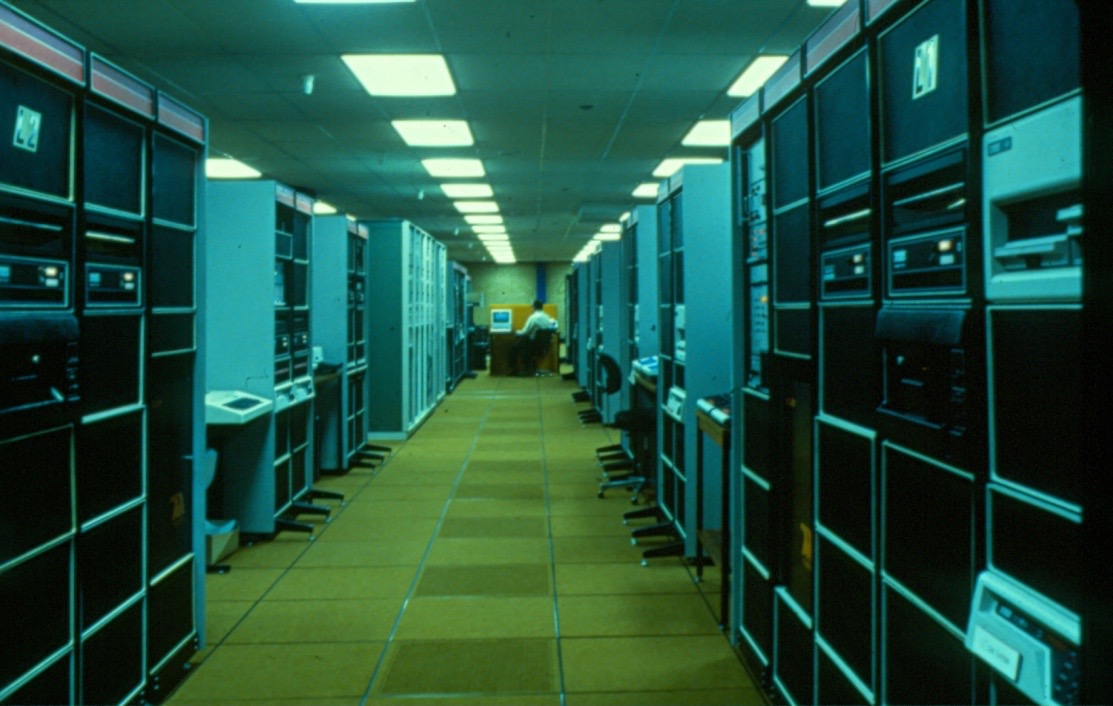
PHOTO: Typical operations centre 1982
- Video conferencing is used for the first time for meetings between London- and New York-based technical and marketing staff. It involves travelling to a hotel in each city but it does work. Quality is appalling by today’s standards and usually involves 15-second freeze frame images rather then moving video. It is an improvement on the telephone.
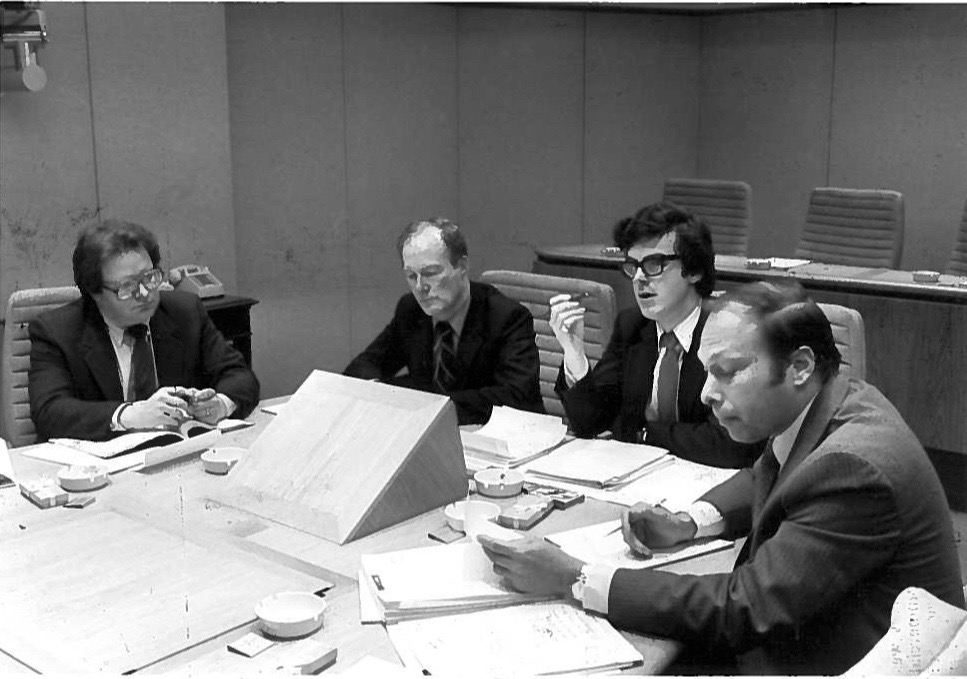
PHOTO: New York end of a video conference with London in February 1983 with (L-R) Michael Reilly, Jack Wigan, Michael Griffin, Arnie Goldman
- First successful launch of Ariane puts a satellite ECS-1 in orbit which is essential for future communications plans for RDN. Another example of Reuters being at the vanguard of communications advances.
- E-mail provided by the VAX software development systems is widely used by global development groups for internal communication. All developers now have a VDU on their desk.
- Special products are now firmly in the product mainstream with typical dealer positions comprising three screens and one programmable keyboard. A Video Matrix Switch (VMS) enables a range of sources to be viewed and a Keyboard Display Driver (KDD) connects the keyboard to any one of five terminal controllers. Apart from Reuters services and in-house systems, access is also provided to a Reuters-provided PC. Software applications such as calculations and arbitrage packages, fed by Reuters data, are sold to be run on the PC.
- RDN objectives are revised as the ambitious Rowgrabber development programme falls behind and the limitations and timescales become unacceptable. A test of the major components developed so far is not impressive. It is decided that the existing Rowgrabber technology cannot be used in the international network because of “historical limitations” in the current design. A new generation will be worked on and be ready in one to two years. Did we really expect to replace 10 years of Monitor, 20 years of QRS plus news that easily? The illusion that replacing complex global information delivery systems is straightforward because of technical advances will return again in the 1990s and the 2000s. The “new RDN” is branded twin track in that it will use a new broadcast approach and use Monitor as a complementary network instead of Reuternet. A series of Standalone Cable Heads (SACs) compile the data stream which is broadcast via a multiplexing device. Instead of broadcasting directly to terminals the data stream is broadcast to a series of database systems known as IDR1000s. They look a bit like a modern day server. Terminals will be hung off these databases located either at the client site or in data centres. Investment in Monitor is allowed to restart. One can certainly sketch out the idea on a whiteboard and it looks somewhat convincing but the sheer complexity of the undertaking both in terms of hardware and software and in terms of the number of components that have to be built make it a daunting development task. Finally the encoding of the data in the television signal means that even standard satellite transmission technology must be modified for the task. Another challenge successfully met by specialist Reuters engineers.
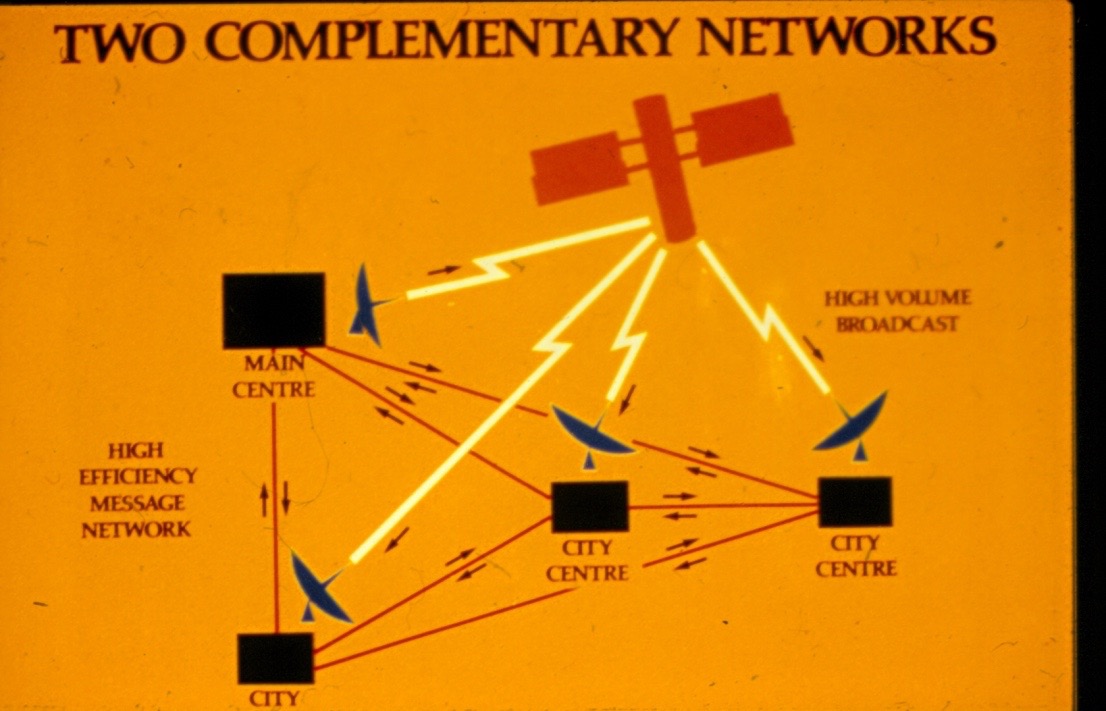
PHOTO: RDN vision
- Technical minds decide to propose an alternative but Glen Renfrew would have to be convinced.
- A lot of design effort has been expended so far which is not completely wasted as much of it will be useful in the next phase.
- Hovland Business Systems is acquired to provide position-keeping facilities for dealers. It promises much but proves to be a distraction and a drain on Reuters development resources.
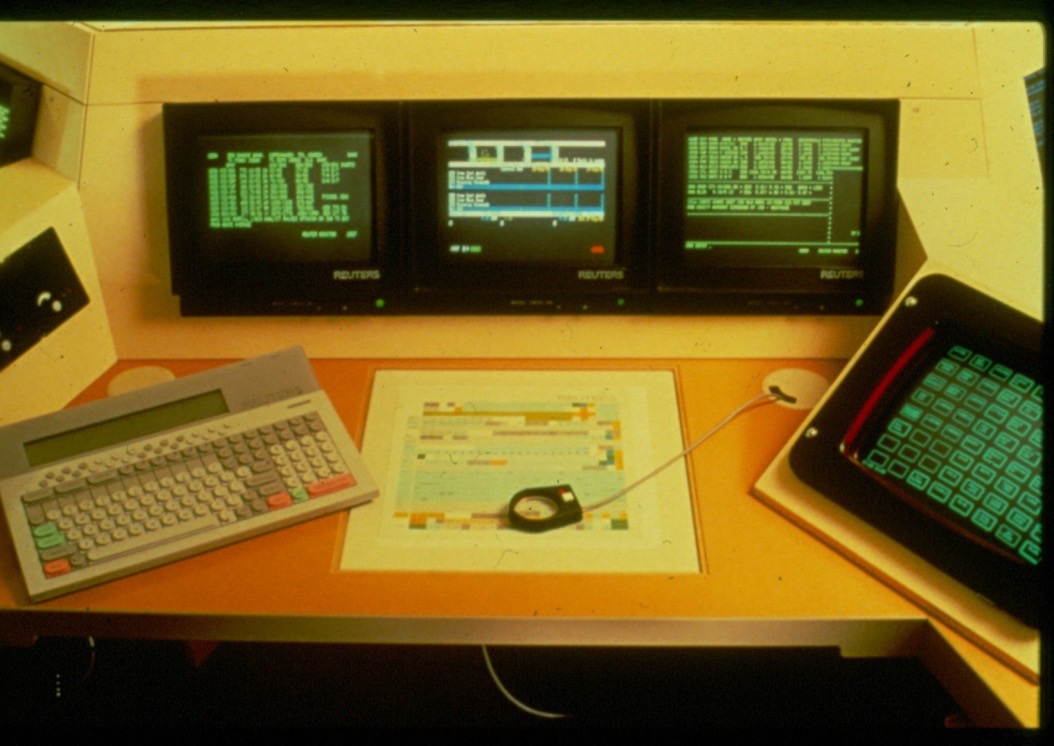
PHOTO: Hovland tablet
- Reuters Asia instals Systems Integrators SII System/55, a new video editing and message switching system to replace the local system after good experiences reported by AAP. It is based on Tandem non-stop computers and an intelligent Coyote terminal with sophisticated editing facilities. Reuters North America announces that it will follow with a similar system, leaving London out on a limb with MS-11B.

- RMDS or Dealing has expanded to more than 550 subscribers in 24 countries and achieves critical mass. Calls average 10,000 per day. This “faster than forecast” increase means that the system suddenly risks hitting performance barriers. With some careful husbanding of the network resources the necessary capacity upgrades are rolled out in time.
- The last Videomaster terminal is withdrawn from service.
PHOTO: Coyote terminals in newsroom
- Three-metre dishes to receive ECS-1 signals are installed at the London and Geneva data centres and a high speed data trial goes ahead. This took substantial arguments at the technical and policy level to convince the PTTs to grant permission. This was yet another step in an evolving story of hard PTT negotiations; high speed modems and multiplexers in the mid-1960s, contributed data for the Monitor system in the 1970s and the dealing service displacing telephone and fax services in the 1980s.
- In London, the National Graphical Association union strikes for 17 days over payments for increased responsibility. The operations staff walk out. The programmers are dragged into the dispute and most walk out too. Managers run the systems and discover how awful the operational interface is on most systems and particularly the miles of paper tape required for routine Monitor file maintenance. Subscriber services are unaffected.
- Work begins on a combined video generator (CVG) which takes in various terminal feeds and combines them on a single screen in different “windows”. It is well ahead of its time but it gets too complicated and is eventually abandoned five years later in favour of Microsoft Windows and a Local Area Network (LAN) approach.
- RMDS is still proving expensive for many customers who are not constant users of the service. A solution from Rich (with whom a marketing agreement exists) is far too expensive and so the Keyboard Hub is developed to allow 12 keystations to access the six controller ports through simple keyboard and screen switching. The sources are designated primary which are dedicated to a user or secondary which are shared. A queue management feature supports users waiting for a secondary service. Barclays Bank is the first client. It is entirely modular, flexible with configurable ratios of sharing and based on field-tested designs.
- A 16-page broadcast service is introduced. A specially configured MES300 terminal holds the 16 pre-defined pages of the service which are refreshed regularly but not updated in real time. It is later expanded to 32 pages and is a cheap and popular product for specialist markets.
- The RDN satellite network completes testing successfully using three-metre dishes in London, Geneva, Amsterdam, Frankfurt and Paris.
- A proposal for an alternative to RDN is made when, after three years in development, the system is still not viable, even after the many design changes made in 1982 and again in 1983. The development task using Rowgrabber technology was just too complex as predicted and feared. Work begins on a re-design to be known as IDN (Integrated Data Network). It is based on a VAX/Intel architecture and uses elements of broadcast. Staff are redeployed to IDN work and can use VAXs again. Rowgrabber continues with its own re-design and with the original purpose of delivery to clients over cable systems. An anonymous developer publishes a pamphlet suggesting 101 uses for a dead SAC, mimicking a popular humorous book of the day - 101 Uses for a Dead Cat.
- A new data protocol is devised for IDN (Marketstream) which defines the name, Reuters Identification Code (RIC), and meaning of the fields in a data item transmitted across the network. It is highly efficient in terms of bandwidth and storage. Record templates enable receiving devices, e.g. terminals, to interpret the information for the many different kinds of data (equities, options, bonds, news, etc) carried. New kinds of data require new templates if their format differs from any of the existing templates. A massive mistake is made when it is decided for reasons of timescale that such changes can only be made with a software release to all affected components. This means proper processing and display of a new data item could take up to two years to implement correctly. The matter has never been resolved satisfactorily.
- For the first time data is now carried in logical format and means that an item can be processed independently of the format of its transmission, e.g. location on a page in the case of Monitor. The use of Ethernet is continued and the design has a major emphasis on expansion by adding systems horizontally rather than by buying bigger boxes. Subscribers will have only one connection for information services instead of several. A new terminal will re-use some the earlier efforts and be based on IDR hardware. A first target is the replacement of the ADP feed of North American quotes with IDN.
- The fundamentals of how data is stored and transmitted for Information services are now defined for the next 25 years at least. Reuters initially refuses to license the RIC naming convention to other service providers which causes some legal hiccups later.
- AAP, which has rights to all Reuters technology, opts to continue with Rowgrabber technology in Australia even though it knows a redesign has commenced. It makes for some difficult liaison trips over the next few years.
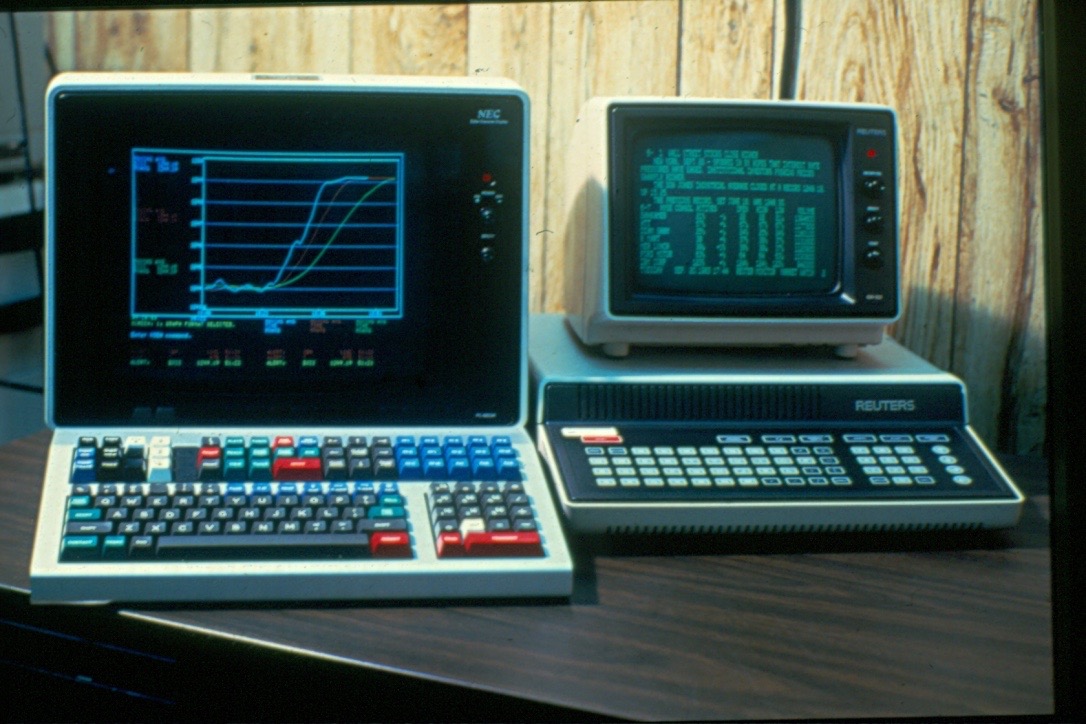
- IDR demonstrates a colour graphics terminal.
PHOTO: IDR Colour Graphics and 4P terminals
- With the delay to RDN, and the transformation into IDN, a solution has to be found for Monitor capacity problems. It is achieved by doubling or dualling the number of hosts in each location. A new concentrator hides the host duality from the terminal. This simple and very effective solution is at the expense of significant capital outlay.
- PCs are connected to Monitor via early versions of data feeds to create add-value or composite pages or directly to a terminal via the printer port. The most significant composite page is FXFX which becomes a standard for Money Rates subscribers. Some applications use key data packed into pre-assigned Monitor pages which can be read and converted into graphs or used in calculations. Reuter Monitor Abacus is one such product which helps forex dealers assess arbitrage opportunities with a facility that constantly scans spot, forward and deposit rates in 24 currencies. Consultants are employed to develop the applications thus bypassing local development bottlenecks. The effect on Monitor loading is a concern as the numerous “add-value” systems jammed on the side of Monitor get out of control. PCs are even rack-mounted to get round the operations real estate problems. Further, they rely on knowing the row/column coordinates to get at the data to be extracted/manipulated. Any change to page formatting wreaks havoc (there are complicated file maintenance procedures which try to avoid this). A single system is developed to perform these functions and replace the PC-based applications. The Monitor Manipulation Processor (MMP) is released in London and is soon expanded to other geographies. Although it creates its own logjam at least there is some control over the traffic created by the myriad of PCs and other microcomputers with in many cases dubious and expensive support arrangements.
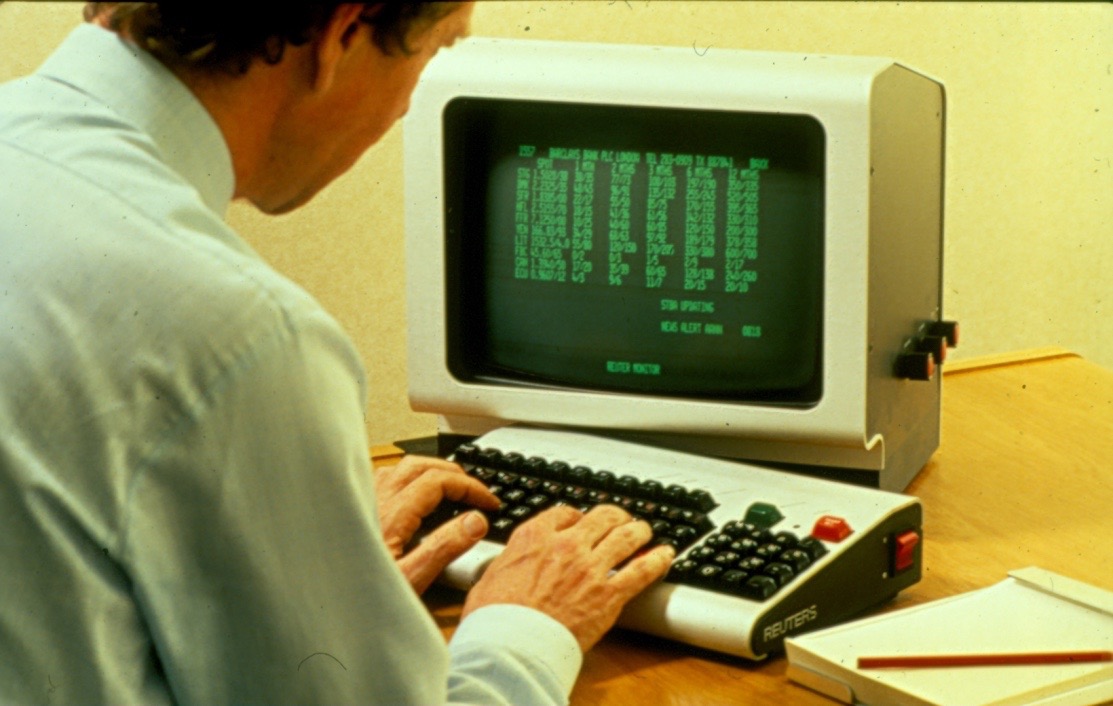
PHOTO: Monitor terminal
- The first data feed product, the Real Time Feed (RTF), is developed for a Canadian bank. It uses completely homegrown hardware and software in a “box” though it will later be ported to a PC card. It allows access to 32 pages of pre-configurable Monitor information by a client computer over a specially designed protocol. The open systems flood gates are ajar. Fears are expressed about cannibalising revenue and the data feeds are priced accordingly. A project is also put in place to reduce the box to a PC card giving a PC direct access to Monitor data. No-one is sure it would be useful and so it is done as an R&D challenge to the special products group. It soon appears in the Advanced Reuter Terminal (ART) a year later.
- Newsyear, a database of textual news, is finally launched based on the still shaky Basis platform, followed by a product for the Eurobond market. A Bond dealing service is also launched using the dealing conversations platform.
- « Previous
- Next »
- 7 of 18